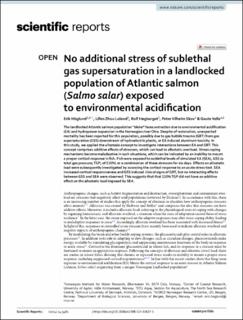| dc.contributor.author | Höglund, Erik | |
| dc.contributor.author | Loland, Lifen Zhou | |
| dc.contributor.author | Høgberget, Rolf | |
| dc.contributor.author | Skov, Peter Vilhelm | |
| dc.contributor.author | Velle, Gaute | |
| dc.date.accessioned | 2024-02-13T08:14:53Z | |
| dc.date.available | 2024-02-13T08:14:53Z | |
| dc.date.created | 2024-02-12T11:15:45Z | |
| dc.date.issued | 2024 | |
| dc.identifier.citation | Scientific Reports. 2024, 14: 3482. | en_US |
| dc.identifier.issn | 2045-2322 | |
| dc.identifier.uri | https://hdl.handle.net/11250/3117125 | |
| dc.description.abstract | The landlocked Atlantic salmon population “bleke” faces extinction due to environmental acidification (EA) and hydropower expansion in the Norwegian river Otra. Despite of restoration, unexpected mortality has been reported for this population, possibly due to gas bubble trauma (GBT) from gas supersaturation (GSS) downstream of hydroelectric plants, or EA induced aluminum toxicity. In this study, we applied the allostasis concept to investigate interactions between EA and GBT. This concept comprises additive effects of stressors, which can lead to allostatic overload. Stress coping mechanisms become maladaptive in such situations, which can be indicated by an inability to mount a proper cortisol response in fish. Fish were exposed to sublethal levels of simulated EA (SEA), GSS (a total gas pressure; TGP; of 110%) or a combination of these stressors for six days. Effects on allostatic load were subsequently investigated by assessing the cortisol response to an acute stress test. SEA increased cortisol responsiveness and GSS induced clinical signs of GBT, but no interacting effects between GSS and SEA were observed. This suggests that that 110% TGP did not have an additive effect on the allostatic load imposed by SEA. | en_US |
| dc.language.iso | eng | en_US |
| dc.publisher | Nature | en_US |
| dc.rights | Navngivelse 4.0 Internasjonal | * |
| dc.rights.uri | http://creativecommons.org/licenses/by/4.0/deed.no | * |
| dc.title | No additional stress of sublethal gas supersaturation in a landlocked population of Atlantic salmon (Salmo salar) exposed to environmental acidification | en_US |
| dc.type | Peer reviewed | en_US |
| dc.type | Journal article | en_US |
| dc.description.version | publishedVersion | en_US |
| dc.rights.holder | © 2024 The Authors | en_US |
| dc.source.pagenumber | 8 | en_US |
| dc.source.volume | 14 | en_US |
| dc.source.journal | Scientific Reports | en_US |
| dc.identifier.doi | 10.1038/s41598-024-53637-5 | |
| dc.identifier.cristin | 2245036 | |
| dc.relation.project | Norges forskningsråd: 294742 | en_US |
| dc.source.articlenumber | 3482 | en_US |
| cristin.ispublished | true | |
| cristin.fulltext | original | |
| cristin.qualitycode | 1 | |

